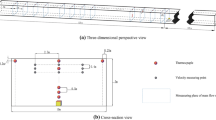Abstract
Theoretical analyses and model-scale experiments have been conducted to investigate the critical velocity in a tunnel cross-passage which is defined as the minimum ventilation velocity through the fireproof door to prevent smoke from flowing into a cross-passage. The effect of the fireproof door geometry, heat release rate, ventilation velocity and fire source location were taken into account. The critical velocity in a tunnel cross-passage varies approximately as 3/2 power of the fireproof door height, as one-third power of the heat release rate and as exponential law of the ventilation velocity, almost independent of the fireproof door width. The critical Froude Number mainly ranges from 5 to 10 and consequently as it is not a constant value it is not very suitable to predict the critical velocity in a tunnel cross-passage. A dimensionless correlation that can correlate well with the experimental data was proposed.











Similar content being viewed by others
Abbreviations
- A :
-
Area (m2)
- C d :
-
Coefficient defined in Equation 14
- c p :
-
Heat capacity of air (kJ/kg K)
- Fr cc :
-
Critical Froude Number
- g :
-
Gravitational acceleration (m/s2)
- H :
-
Height (m)
- l :
-
Length (m)
- m :
-
Mass flow rate (kg/s)
- Q :
-
Total heat release rate (kW)
- Q c :
-
Convective heat release rate (kW)
- T :
-
Temperature (K)
- V :
-
Ventilation velocity (m/s)
- V cc :
-
Critical velocity in a tunnel cross-passage (m/s)
- ρ :
-
Density (kg/s)
- a :
-
Cross-section no
- b :
-
Cross-section no
- c :
-
Cross-section no
- d :
-
Fireproof door in a cross-passage
- f :
-
Smoke flow
- r :
-
Full scale
- o :
-
Ambient
- m :
-
Small scale
- t :
-
Tunnel
- * :
-
Dimensionless
References
R. O. Carvel, G. Marlair. A history of fire incidents in tunnels. In: AN Beard and RO Carvel, Editors, The handbook of Tunnel Fire Safety. (A. N. Beard and R. O. Carvel, Eds.), London, Thomas Telford Publishing, 2005, pp. 3-41.
Kennedy WD, Parsons B (1996) Critical velocity: past, present and future. Seminar of smoke and critical velocity in tunnels. London, UK, pp 305–322
Y. Wu, M.Z.A. Bakar. Control of smoke flow in tunnel fires using longitudinal ventilation systems - a study of the critical velocity. Fire Safety Journal. 2000; 35:363-390.
Hall RC (2006) Ventilation during road tunnel emergencies. Published project report, PPR140. TRL Limited, Berkshire
D. H. Kim, W.H. Park. Experiment by using reduced scale models for the fire safety of a rescue station in very long rail tunnel in Korea. Tunnelling and Underground Space Technology. 2006; 21:303.
Tarada F, Bopp R, Nyfeler S (2000) Ventilation and risk control of the Young Dong Rail Tunnel in Korea. 1st international conference on major tunnel and infrastructure projects, Taiwan
Tarada F (2000) Critical velocities for smoke control in tunnel cross-passages. 1st international conference on major tunnel and infrastructure projects, Taiwan
Y. Z. Li, B. Lei. Model of critical velocity in a tunnel cross-passage. Journal of the China Railway Society. Beijing: 2008, 30(3):87-90.
J. G. Quintiere, Scaling application in fire research. Fire Safety Journal.1989; 15:3-29.
G. Heskestad. Modeling of enclosure fires. 14th symposium on combustion. The Combustion Institute, University Park, PA, 1972. pp 1021-1030.
Saito N, Yamada T, Sekizawa A, Yanai E, Watanabe Y, Miyazaki S (1995) Experimental study on fire behavior in a wind tunnel with a reduced scale model. In: Second international conference on safety in road and rail tunnels, Granada, Spain, April 1995, pp 303–310
G. Heskestad. Physical modeling of fire. Journal of Fire and Flammability. 1975; 6:253-273.
H. Ingason. Model scale railcar fire tests. Fire Safety Journal. 2007; 42:271-282.
H. Ingason. Model scale tunnel tests with water spray system. Fire Safety Jounal. 2008; 43: 512-528.
Acknowledgements
This work was sponsored by the ministry of railway of the People’s Republic of China which is gratefully acknowledged. The authors would also like to thank adjunct Prof. Zhihao Xu and adjunct Prof. Zhihui Deng for their help in these experiments. Acknowledgement to SP Tunnel and Underground Safety Centre for the support to the project.
Author information
Authors and Affiliations
Corresponding author
Rights and permissions
About this article
Cite this article
Li, Y.Z., Lei, B. & Ingason, H. Theoretical and Experimental Study of Critical Velocity for Smoke Control in a Tunnel Cross-Passage. Fire Technol 49, 435–449 (2013). https://doi.org/10.1007/s10694-010-0170-0
Received:
Accepted:
Published:
Issue Date:
DOI: https://doi.org/10.1007/s10694-010-0170-0




